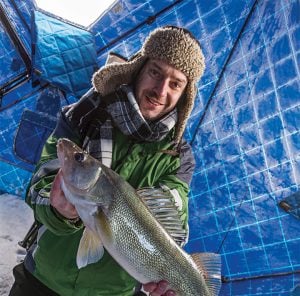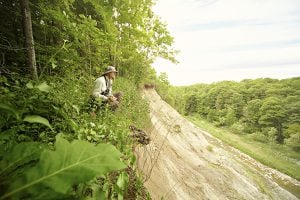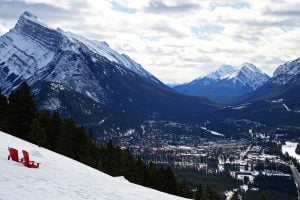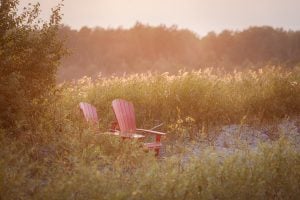Last week, Environment and Climate Change minister Catherine McKenna visited the Nunatsiavut region of northern Labrador and Torngat Mountains National Park. Canadian Geographic joined her tour of the area. Here’s an exclusive interview conducted at Torngat Mountains Base Camp and Research Station with the minister about her tour, her priorities and more.
For starters, tell us why you’re here?
I came here for a couple of reasons. One, I was very interested in coming because I heard it’s absolutely stunning, but also because it’s our only park that’s entirely Indigenous led. All of our staff are Inuit and there’s also an Inuit cooperative management board. I’m very interested, as part of reconciliation, in trying to understand what we might be able to do in terms of the future of parks and protected areas in working much more closely in partnership with Indigenous Peoples.
The second thing that’s a clear focus is climate change. We need to be doing more on the science side and really trying to understand the impacts of climate change both in the short and longer term, and this is a perfect living laboratory. I’m thinking about what more we can do to link Environment and Climate Change Canada scientists to our park ecologists and biologists and what more we could do to use these parks and our amazing parks people and Indigenous Peoples to advance our knowledge of the effects of climate change. We know it’s happening much faster in the Arctic, and what happens in the Arctic doesn’t stay in the Arctic.
Can the Torngat Mountains National Park’s cooperative management board (the all-Inuit local group that advises Parks Canada on decision making in the park) and its all-Indigenous leadership model be exported to other national parks?
For sure. I think that’s really the future of how we do things. Parks has evolved from the time where you could just say ‘I’m creating a park’ and you didn’t worry about the Indigenous or local communities, to a point where we want to be working directly with the people who often live right on the land. You could see that at the cooperative management board meeting [which the minister attended during her visit]. It was an amazing experience because they talked about the relationship with caribou. It’s kind of self-evident, but the decisions made by the federal government on species-at-risk like caribou have a direct impact on Inuit. Not just on country food, which is really important, and food insecurity and the cost of food, but also for their culture and the connection between elders and youth to the land. Having them directly involved in the decisions that impact them makes sense. One thing I’ve learned though is every community is different. Here we have Nunatsiavut Inuit and Nunavik Inuit. I don’t know if this exact model is something that works everywhere, but you work really hard to develop good relationships and trust, and then you look at how you can have real partnerships to make better decisions. It’s had me think outside the box.
How will you bring Environment Canada and Climate Change scientists and Parks Canada scientists together?
It’s interesting because folks in parks are focused on what’s happening in parks, whereas Environment and Climate Change Canada scientists or climate scientists are looking at a macro scale. I think that presents a real opportunity to look at how people on the ground can monitor long-term projects, and link that to our broader objectives. Under the previous government there were major cuts to science, including parks, and that had an impact. Now more than ever we need to invest in science, and we should be leveraging all of our assets. There’s a lot of opportunities and I just want to make sure that we’re being smart about how we do things. Once again, this is a living laboratory. You couldn’t have a better spot to do more research and partner with the local community. I think there’s a lot more we could be doing with the local community, like engaging them in monitoring.
Are there examples that have emerged during your visit where you see you can do more for the local community?
It’s clear there’s more that can be done. The park here had a youth program, and having young people come up and connect with the land is really important. It’s a far place to go, but imagine the impact when you understand how your ancestors lived or you visit Hebron [a Moravian mission site], which I had a chance to do and see and understand more about the history here. Some of it is pretty tough history, with all the relocations that separated families.
We announced in the budget an Indigenous guardians program, and it’s become clear to me that it has to be Inuit led, and it has to meet the objectives of Inuit in both protecting very sacred sites, educating people that come here and, really importantly, having the connection between elders and young people in passing on traditions and culture and history.
In terms of science, the cooperative management board could have an increased role with protecting caribou and conservation, but also really understanding that there are ways you can sustainably harvest caribou. When you approach species-at-risk, you think about the longer term and you build in a small harvest where you have the connections with elders and young people who understand how to properly hunt in different circumstances. I’m going to bring that back [to Ottawa] and look at how we create real partnerships that are mutually beneficial.
How do you feel personally about Bear 148 being relocated outside of Banff National Park after its numerous run-ins with visitors this year, many of which were provoked by visitors getting too close?
Sometimes it’s a challenge between protecting wildlife and keeping humans safe. There was a good outcome in this case, in the sense that the bear wasn’t euthanized. We are going to have to pay more attention to this in parks where you have a lot of people. This is going to be an issue in the mountains parks in particular. How do you manage interactions between wildlife and humans in a way that is safe for both? As you know, we’ve had historic numbers of visitors [to National Parks] this year. After this season, we’ll have a chance to look back at the very high levels of visitation and assess what needs to be done to get the right balance. Maintaining ecological integrity is a top priority in the parks. Of course, we want people to visit them, and it’s great that we’ve had record numbers, but you need to make sure that you have the right balance. That’s going to be an important conversation.
What’s your position on an Environmental Bill of Rights, a concept David Suzuki has promoted in recent years?
It’s an interesting question. I think you always have to look at implications and what does an Environmental Bill of Rights mean? I have key priorities including partnership with Indigenous Peoples. How environmentalists might approach things and how Indigenous Peoples might approach things aren’t always exactly the same. Another of my priorities right now is the minister’s roundtable, which is great because it gives you the chance to step back and look at what’s worked and what hasn’t, and what the future of parks are going to be. I’m also really focused on ecological integrity of science.
The third thing is on the broader economic value of parks beyond the gate fees. What’s the benefit of parks to the local community? The money and tourism they bring in has a very significant impact, but also come up with a value of parks, because sometimes people don’t understand that it’s not just gate fees. Parks are really important as carbon sinks and for health. Not everything has to have a dollar value, but if you can convey that a bit better, the benefits to a local community, I think that’s a good way of making the case of the real importance of our parks and connecting people to nature.
When you talk about putting an economic value on parks beyond gate fees, does that extend to valuing trees and forests, for instance, and the overall environment and its benefits to society?
I think we really undervalue how much parks mean to us if you don’t get the broader economic impact. Think of Vancouver, and its value as a green capital – that’s much more than just tourism. There’s a real opportunity to do that [with parks]. Look at how so many young people don’t get enough exercise, who don’t get enough time with nature. I think we really need to be valuing our parks and protected areas more. We’re very focused on meeting our Aichi targets [an international biodiversity agreement in which Canada agreed to conserve 17 per cent of terrestrial area and 10 per cent of marine environment by 2020]. They’re ambitious in the Canadian context, but I think they’re really, really critically important. We’re working hard with the provinces and territories, I’ve been spending a lot of time with them, and they want to support our efforts.
What are Environment Canada and Parks Canada doing to meet Canada’s Aichi target commitments, particularly protecting 10 per cent of our marine environment by 2020?
We are looking at all the different opportunities. One thing is Indigenous protected areas, which would be a different approach to protected areas where we’d work very closely with the Indigenous community to understand what they value and why they would want a protected area and what the Indigenous rights would be in that context. Australia’s done this. In the Arctic, when you think about how important it is to protect many of these areas, but also the importance of the land to Inuit and having an opportunity to benefit from the land, I think you can come up with something that’s different from a park, but meets the same overarching objective. We’re very committed, and that’s why we’re also going to come out with our pathway to meet our Aichi targets next year.
What has personally impacted you during your time in Torngat Mountains National Park?
How incredibly beautiful it is. It’s hard to even appreciate that you have these huge cliffs that go right into these waters, and fjord after fjord where every time you turn around, bang, it’s a different view. Also, meeting Inuit who live here and realizing that parks are much more than parks. There’s a tendency to focus on the biodiversity, the animals and how beautiful they are. But in this case, people live here, and there’s a really long history, and that has to be part of how we tell the story of the park.
This interview has been edited and condensed for clarity.





